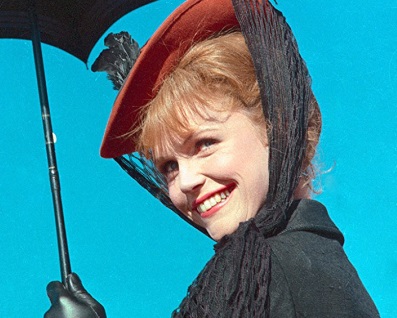(This review originally appeared online at Bumscorner.com in 2007.)
After having LSD secretly slipped into their drinks at a New Year's Eve party, Kevin (Al Santos, JEEPERS CREEPERS II) and his girlfriend Tiffany (Sandra McCoy, CRY WOLF) spend a terrifying night lost in the icy-cold woods, fleeing from a killer who may or may not be a figment of their drug-addled imaginations in 2007's DEAD OF WINTER (aka LOST SIGNAL).
Prolific television actor Brian McNamara makes his directing debut while also playing the small-town police chief trying to locate the missing pair. He does a pretty good job in both capacities, managing to squeeze a fair amount of suspense out of a script that consists mainly of Kevin and Tiffany running through the woods screaming and hallucinating a lot. He also handles some of the character scenes nicely, especially the comeraderie between the easygoing chief (McNamara) and his staff, sassy 911 operator Nancy (Ella Joyce, BUBBA HO-TEP) and cute deputy Dani (Lindsay Thompson), with whom he's sweetly smitten.
The question of whether or not there's really someone after Kevin and Tiffany remains intriguing throughout most of the story, with the main characters' severely altered mental states causing them to experience some pretty weird things. When they happen upon a group of workmen standing in the middle of a dark field and are unable to communicate with the silent, unmoving figures, it's "Twilight Zone" territory.
When a snowcat suddenly comes to life and tries to mow them down, we get a vibe similar to DUEL or KILLDOZER. And when Kevin finally goes off the deep end and suspects Tiffany of being the one trying to kill him, there's a reprise of the final sequence from THE SHINING in which Kevin even quotes Nicholson's Jack Torrence: "I'm not gonna hurt ya, Tiffany...I'm just gonna bash your f**kin' brains in!"
The icy, moonlit forest scenes have an eerie look to them and the production values are generally good. I found myself wishing Ryan Demaree's musical score had eased off the "eleven" button a bit more often, though. The cast, especially McNamara, Joyce, and Thompson, do the best they can with their roles, and while the two leads aren't all that impressive, they manage to convey prolonged terror and disorientation pretty well.
Ultimately, DEAD OF WINTER is nothing special, but it's just well-done enough to make it fairly entertaining. The closing scenes have a surprising emotional depth, and there's a final revelation before the credits which, while hardly mind-boggling, still wraps things up with a mildly satisfying twist. I didn't regret sitting through it, but it's strictly a take-it-or-leave-it sort of flick.









